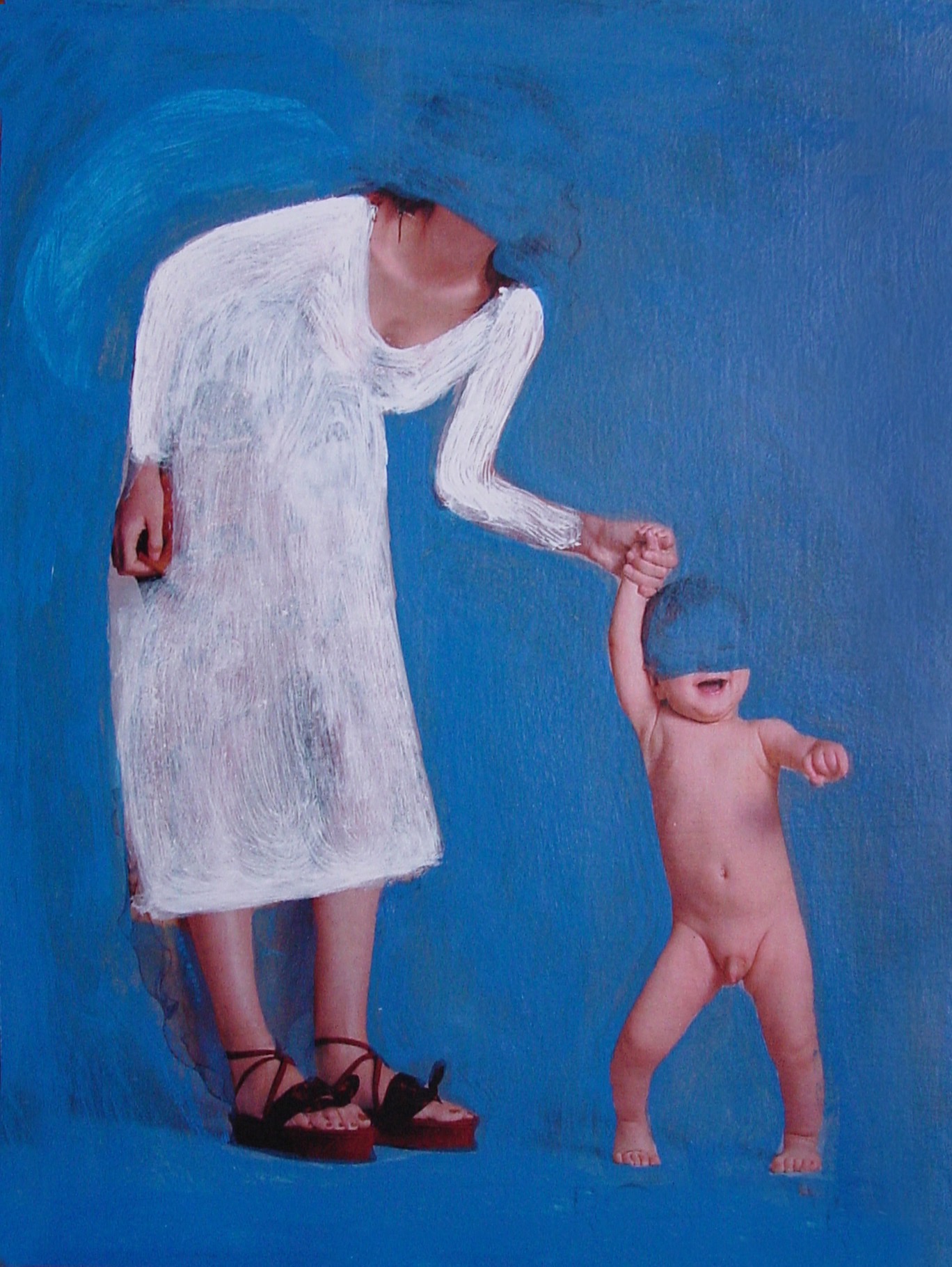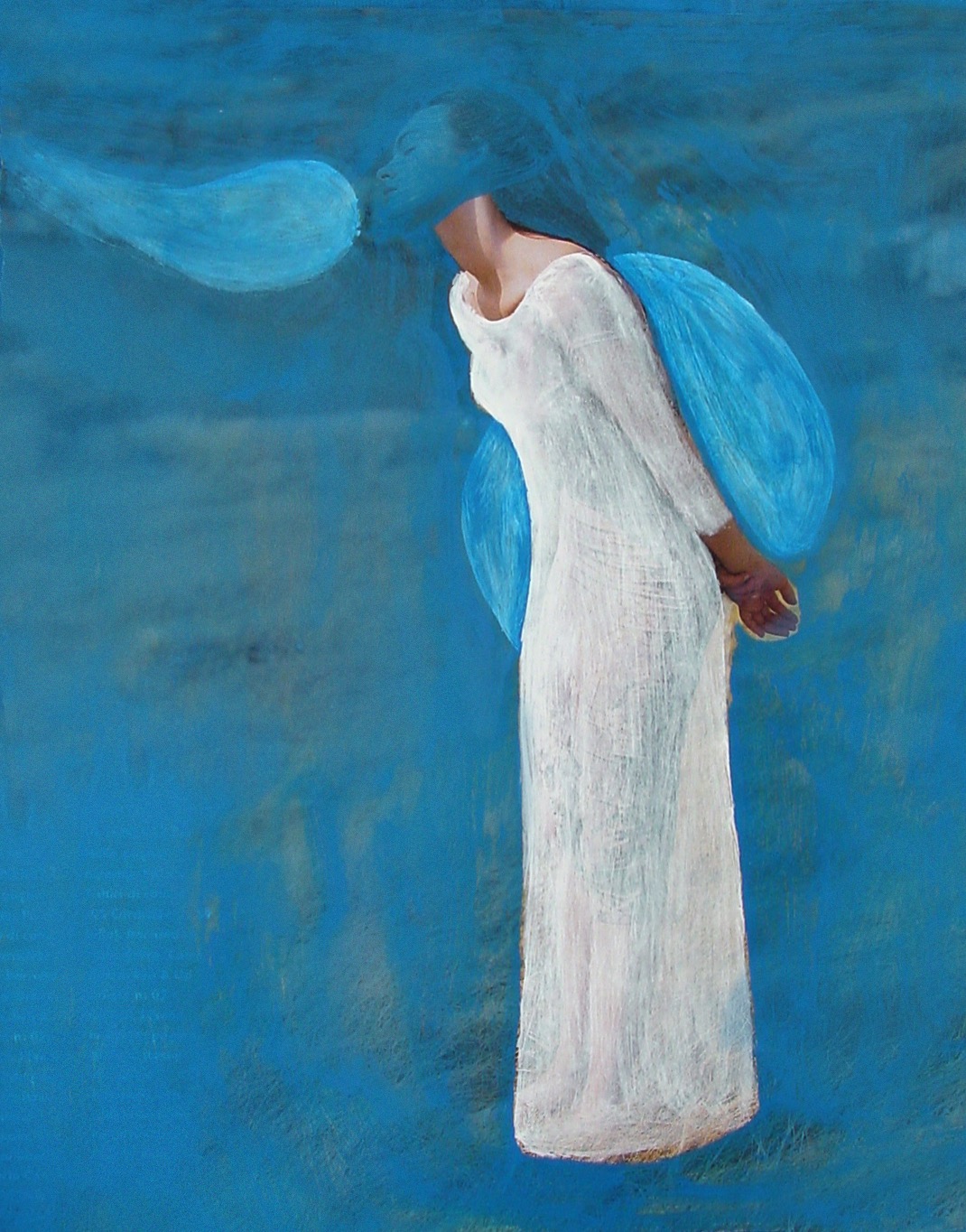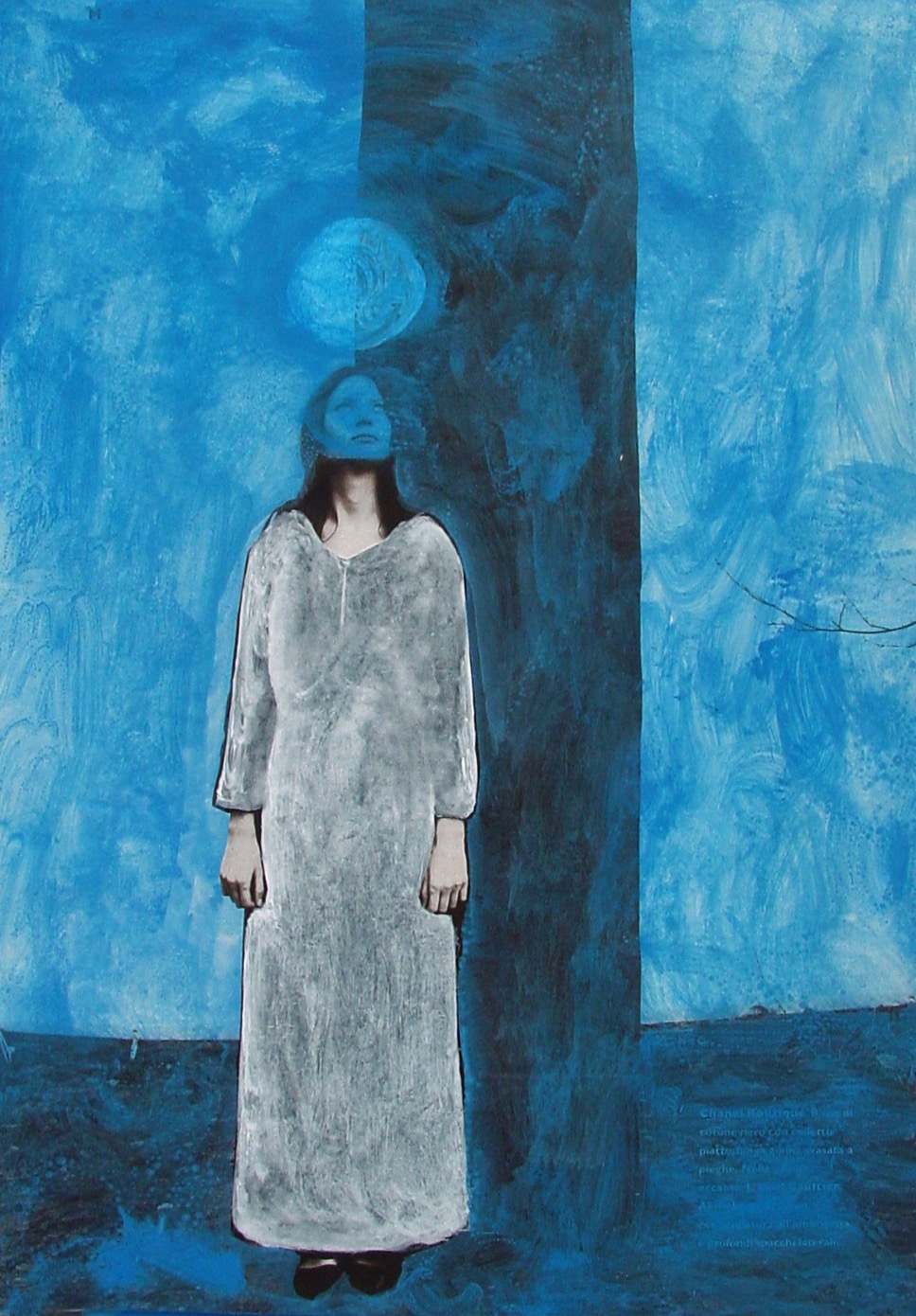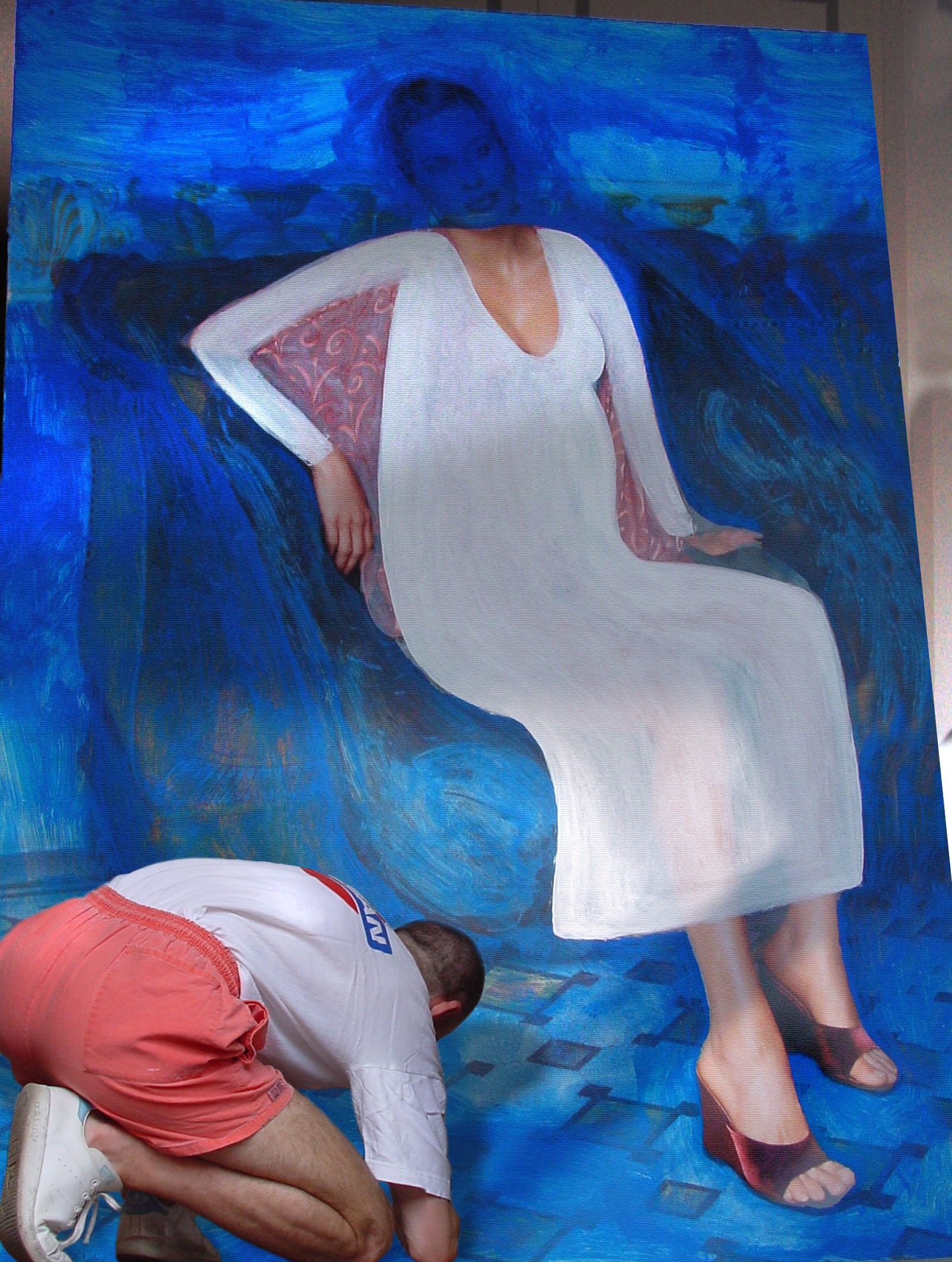Una tesi
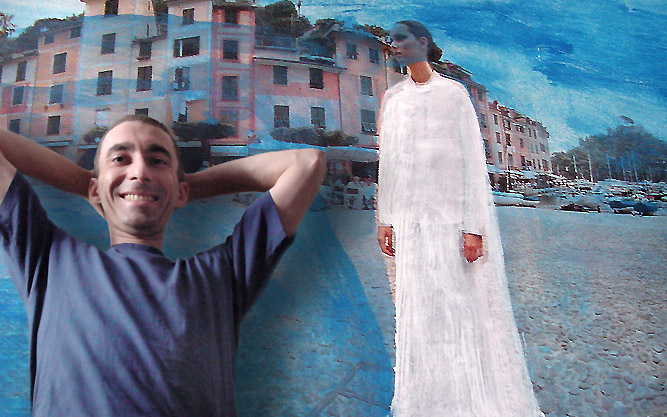
di MARTINA SANTIMONE
2002
Un giorno, qualche anno fa, ebbi modo di ammirare, ad una mostra, dei quadri blu che mi colpirono molto. Erano grandi e ognuno era caratterizzato da figure senza volto, o meglio, con il volto cancellato dal colore. Esse erano state vestite, mediante la pittura, di bianco.
Sembravano delle Madonne e degli angeli, immersi in un cielo profondo, di un blu intenso ma che non copriva uniformemente le superfici. Lasciava trasparire un po’ di quella che era la realtà sottostante, di quelle donne che erano “rubate” dai loro ambienti per diventare delle creature angelicate, metafisiche, universali.
Mi piacquero molto quei lavori, forse per la loro misticità, per il loro voler volare via dalla realtà, aprirsi a nuovi cieli e a nuovi mondi.
Il creatore di quelle opere è Riccardo Paracchini.
Col tempo ebbi modo di recuperare qualche catalogo delle sue mostre, di leggere alcuni suoi testi su una rivista da lui ideata con Luca Scarabelli, “Vegetali Ignoti”, di conoscere altre sue opere sul suo sito Internet…e pian piano rimasi sempre più affascinata dai suoi dipinti, tanto da arrivare ad appenderne in camere le riproduzioni o conservare nel portafoglio dei piccoli “santini”.
Un giorno gli scrissi.
Iniziò così un piacevole scambio di e-mail poiché io ero molto curiosa di avvicinarmi alle sue creazioni.
E lo incontrai.
Ebbi la fortuna di vedere decine di quadretti, di disegni, di tele, e di ascoltare mille parole sull’arte, sulle sue opere, sui colori, sulla poesia.
Scoprii il suo curioso percorso artistico che partì con l’utilizzo del rosso su pezzi di carta da parati, per poi passare all’uso del blu e del rosa su immagini di fiori e di donne.
Mi incuriosì molto l’origine delle opere blu.
Un tempo egli scrisse una favola con un linguaggio antico, compiendo una ricerca sulla poesia tra il 1200 e il 1400, sullo stile stilnovista e dantesco.
Nacque così una ricerca anche sulla pittura nella storia dell’arte di quel periodo che venne poi riproposta concretamente nelle sue opere.
I fondi blu infatti, derivano dal colore che veniva utilizzato per gli sfondi di quell’epoca e poi hanno un preciso intento, quello di dare l’idea di un qualcosa di asettico, irreale, ideale e spirituale.
Il blu vuole portare la realtà in una dimensione metafisica e il fatto di nascondere il volto delle donne svuota l’individualità, il ritratto del singolo, la rende anonima ma nello stesso tempo le fa assumere un valore universale.
Paracchini usa la pittura per ricostruire la realtà ma anche per modificarla. Sceglie infatti delle immagini di riviste, immagini che fanno parte della realtà, o comunque la rappresentano, per poi intervenirci con un processo pittorico che fa assumere loro altri significati e li porta in un’altra dimensione. La pittura serve per costruire. Per costruire un mondo nuovo, un mondo ideale. Per vestire la figura, per moralizzarla.
Negli ultimi tempi poi, egli aggiunge alle sue figure le ali.
Le ali disse che servono per far volare le persone, per dar loro un’altra identità, un carattere più spirituale. E finiamo per incontrare poi, un dipinto di una Madonna…con le ali. Segno che non è importante la rappresentazione fedele del soggetto, ma che rilevante è il significato che le si fa assumere, in questo caso sottolineando ancor di più il concetto ideale dell’opera.
Dietro ad ogni lavoro poi, egli scrive una frase.
Scrive un insieme di parole che giungono dalla radio, da lontano, dall’etere, nel momento in cui sta firmando l’opera. Canzoni che sente alla radio. Non sono sempre frasi complete perché mentre lui scrive una parte, la musica prosegue e vengono messe insieme parti di diverse frasi.
Negli anni perdono la loro temporalità e diventano ricordi, poesie che assumono anch’esse un’aura metafisica.
Me ne piacque particolarmente una.
“I tuoi occhi che mi stanno a guardare”
Fui talmente incantata da questa “pratica” che la sera stessa volli provare anch’io!
Qualcosa di buono ne uscì.
Gli chiesi il significato che lui dava a quel colore tanto amato da me.
Egli lo collegava immediatamente all’idea della pittura, probabilmente legato alla sua storia personale, nella quale il blu ha assunto un ruolo fondamentale.
Ma poi pensò anche alla profondità, al rumore del mare, al periodo dell’infanzia, alla fanciullezza.
Nella sfera reale il blu è spesso sinonimo di freddezza ma nel campo spirituale è sintomo di una profonda sublimazione dei sentimenti.
È un colore che evoca la creazione.
Mi colpì anche il curioso fatto di lasciar in evidenza gli errori, i cambiamenti operati nel corso della realizzazione. Mi feci così raccontare il motivo di questa scelta che egli fece risalire al raggiungimento di una sorta di livello di conoscenza, di comprensione di sé per cui si accettano e si riconoscono gli errori. Un processo di avanzamento morale e di crescita.
Estratto dalla tesi di Martina Santimone, 30 Gennaio 2003.
GOOGLE TRANSLATION
One day, a few years ago, I had the opportunity to admire, at an exhibition, some blue paintings that struck me a lot. They were large and each one was characterized by faceless figures, or rather, with their faces erased by the color. They had been dressed, through painting, in white.
They looked like Madonnas and angels, immersed in a deep sky, of an intense blue but which did not uniformly cover the surfaces. It let a bit of what was the underlying reality shine through, of those women who were “stolen” from their environments to become angelic, metaphysical, universal creatures.
I really liked those works, perhaps for their mysticism, for their desire to fly away from reality, to open up to new skies and new worlds.
The creator of those works is Riccardo Paracchini.
Over time I had the opportunity to recover some of his exhibition catalogues, to read some of his texts in a magazine he created with Luca Scarabelli, “Vegetali Ignoti”, to learn about his other works on his website… and little by little I became more and more fascinated by his paintings, so much so that I ended up hanging reproductions in my rooms or keeping small “holy cards” in my wallet.
One day I wrote to him.
Thus began a pleasant exchange of e-mails because I was very curious to get closer to his creations.
And I met him.
I was lucky enough to see dozens of paintings, drawings, canvases, and to listen to a thousand words about art, his works, colors, poetry.
I discovered his curious artistic path that began with the use of red on pieces of wallpaper, and then moved on to the use of blue and pink on images of flowers and women.
I was very curious about the origin of the blue works.
Once he wrote a fable with an ancient language, carrying out research on poetry between 1200 and 1400, in the stilnovist and Dantesque style.
Thus a research was born also on painting in the history of art of that period which was then concretely re-proposed in his works.
The blue backgrounds in fact, derive from the color that was used for the backgrounds of that era and then have a precise intent, that of giving the idea of something aseptic, unreal, ideal and spiritual.
The blue wants to bring reality into a metaphysical dimension and the fact of hiding the women’s faces empties individuality, the portrait of the single, makes it anonymous but at the same time makes it take on a universal value.
Paracchini uses painting to reconstruct reality but also to modify it. In fact he chooses images from magazines, images that are part of reality, or in any case represent it, to then intervene with a pictorial process that makes them take on other meanings and takes them into another dimension. Painting is used to build. To build a new world, an ideal world. To dress the figure, to moralize it.
Lately, he has added wings to his figures.
He said that wings are used to make people fly, to give them another identity, a more spiritual character. And then we end up meeting a painting of a Madonna…with wings. A sign that the faithful representation of the subject is not important, but that the meaning that is given to it is relevant, in this case underlining even more the ideal concept of the work.
Behind each work, he then writes a sentence.
He writes a set of words that come from the radio, from far away, from the ether, at the moment in which he is signing the work. Songs that he hears on the radio. They are not always complete sentences because while he writes a part, the music continues and parts of different sentences are put together.
Over the years, they lose their temporality and become memories, poems that also take on a metaphysical aura.
I particularly liked one.
“Your eyes that are watching me”
I was so enchanted by this “practice” that that same evening I wanted to try it too!
Something good came out of it.
I asked him the meaning he gave to that color so loved by me.
He immediately connected it to the idea of painting, probably linked to his personal history, in which blue has assumed a fundamental role.
But then he also thought of depth, the sound of the sea, the period of infancy, childhood.
In the real sphere, blue is often synonymous with coldness but in the spiritual field it is a symptom of a profound sublimation of feelings.
It is a color that evokes creation.
I was also struck by the curious fact of leaving the errors, the changes made during the realization, in evidence. So I asked him to tell me the reason for this choice that he traced back to the achievement of a sort of level of knowledge, of self-understanding for which one accepts and recognizes errors. A process of moral advancement and growth.
Altri Testi…
